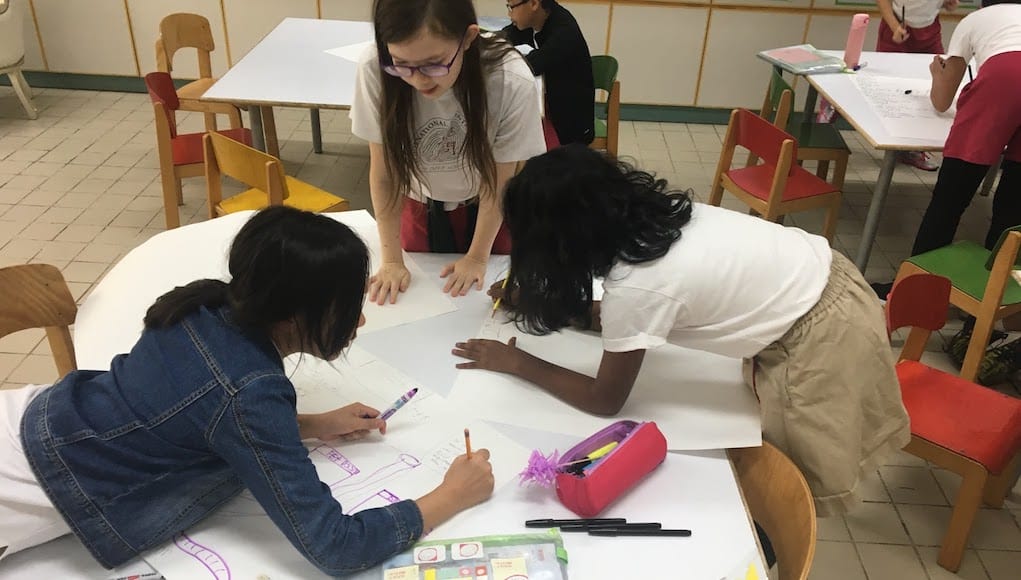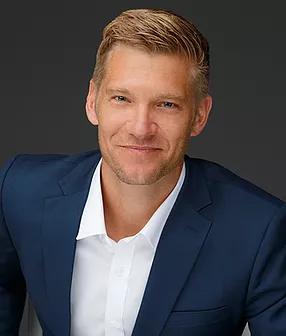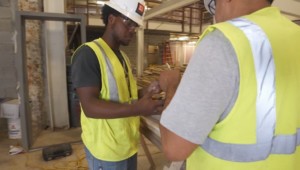How to Give Students Future-Ready Skills Through Community Service

 Two students feed strips of recycled paper into a paper shredder. They will soon blend the paper into a pulp and let it dry in paper frames for future classroom use. They are hoping to encourage a lower carbon footprint amongst their peers. Meanwhile, two floors above them, a group of older students pace around the campus, equipped with tape measures and clipboards. They are busy creating scaled maps of each floor for the scavenger hunt they will hold in three weeks time. To participate, students will be required to trade in a book and one article of clothing. In a smaller meeting room down the hall, students work collaboratively in a Google Doc on a writing piece they will soon publish. They are busy creating the school’s first student-led newsletter and video news podcast for the new school website.
Two students feed strips of recycled paper into a paper shredder. They will soon blend the paper into a pulp and let it dry in paper frames for future classroom use. They are hoping to encourage a lower carbon footprint amongst their peers. Meanwhile, two floors above them, a group of older students pace around the campus, equipped with tape measures and clipboards. They are busy creating scaled maps of each floor for the scavenger hunt they will hold in three weeks time. To participate, students will be required to trade in a book and one article of clothing. In a smaller meeting room down the hall, students work collaboratively in a Google Doc on a writing piece they will soon publish. They are busy creating the school’s first student-led newsletter and video news podcast for the new school website.
Welcome to the junior C.A.S. programme; a program designed for elementary-aged students to develop leadership and skills for the future by taking on projects that create a positive impact in the community.
All projects are student organized, student-designed, and student-managed. The only adult role is to help support groups in setting goals, and following through on their desired outcomes.
And the students have big goals.
Their BIGGEST goal? Raise enough money to support a start-up restaurant that aims to employ and feed children in Cebu that are suffering from poverty. The restaurant needs $20,000 USD to get started. The students have already raised half of that amount.
‘Future-Ready Skills’
In addition to the obvious impact these projects will have on the community, the projects also help students develop key future-ready skills. Students learn to solve problems, think creatively, manage uncertainty, and most importantly, how to coordinate and work with others. According to the Future Jobs Report put out by The World Economic Forum, these are the same top 5 future skills needed for 2020.
Do your students complete Community Service Projects? How do you support them?
The purpose of this post is to help you get started with your community service programme and provide simple strategies for how to empower your students to develop future-ready skills.
5 ways to Develop Future Ready Skills through Community Service Projects
Future Skill #1: Complex Problem Solving:
Community service projects all demand a fair share of problem-solving. When the papermaking project created excess pulp, students had to determine what to do with the unwanted waste. When drawing up maps for their interactive treasure hunt, students had to ensure they were readable for peers from age 6-13. And finally, when the candy graham group couldn’t afford to purchase lollipops for their event, they had to reach out to the parent community to find a more affordable supplier.
These were problems that students ran into naturally as part of the project process. Fortunately, many of them were fairly easy to solve.

Implications for Practice: How to develop problem-solving skills?
When working with students on community service projects, it’s important to guide them in the direction of the “lowest hanging fruit.” That usually starts within the school. While it’s tempting to try and tackle huge problems like global warming or poverty, I have found with younger students, it’s hard to get them to take concrete action steps towards resolving these issues.
Instead, start them with an area they have direct control over. Brainstorm a series of school problems, and determine which are the easiest to tackle. I have found topics like school lunch, recess, beautification, and student behavior to be the most meaningful to students, and also the most empowering for students when attempting to solve.
Future Skill #2: Critical Thinking
After a lengthy deliberation of possible project ideas, grade 4-5 students decided upon a treasure hunt. Their plan was to invite students in on a weekend to the school to search for hidden treasures by using a map and set of clues. Admission to the scavenger hunt required either a book, or article or clothing. These items would be donated to an orphanage who seeks to clothe, shelter and care for abandoned orphans.
Each stage of the project demanded a high level of critical thinking. How would they take obscure and detailed maps and make them kid- friendly? How would they coordinate the clues with the map? How would they make the clues difficult enough to demand teamwork, but simple enough to provide scavenging teams with some momentum? How would they arrange teams? Which day would guarantee the highest amount of attendees?
These questions require students to dig under the surface and reach out to numerous students and adults for answers. Each answer they received helped empower them for the next step of the process until eventually, they were ready for their event.

Implications for Practice: How to develop critical thinking skills?
As important as it is to get students started in the creation process, it is equally important to get them to ask questions. Provide them with a large piece of butcher paper, some markers, and the task to generate at least five questions to explore. This will ensure that they better understand the community problem they are hoping to address. As they gather information, provide a format for them to share answers with the group.
Future Skill #3: Creativity
A rambunctious group of year 5 boys decided they wanted to tackle the issue of recycling. But they were stuck from Day One. They were stuck in a revolving cycle of, “We could do this…” “No, that’s dumb.” “What about this?” “Nah, too hard.” During the first three C.A.S. meetings, it was like watching a revolving record; lots of ideas, but no action.
After watching this for three weeks, I finally decided to intervene. I provided them with a butcher paper, some post-its, and pens. I asked them to think of as at least 41 ways to tackle the recycling problem at the school. When they were finished, I drew two sets of lines on a horizontal and vertical axis. On the horizontal axis; “Low Impact,” “High Impact”; and on the vertical axis; “Easy to do,” “Hard to do.” Students then placed each idea in its respective quadrant.
This process helped them finally stumble upon an idea: they would make toys out of the recyclables. Fast forward to now, 2 months into the project. They have a youtube channel, 5-10 different recyclable toys, and plans for a school carnival made entirely of recyclables. Their group name: ‘Recycabros.’

Implications for Practice: How do you develop student creativity through C.A.S.?
It is important you have some processes in place to help students develop their ideas. IDEO, a popular design company that helps organizations develop divergent thinking, insists that it takes as many wild ideas as possible before organizations come up with their best one (see this article). They insist that rapid prototyping always beats careful planning. The same rule can be applied with students.
The most important thing is to get things started. By taking concrete action towards a community problem, students will gain the immediate feedback they need to move the project forward. The most successful groups I have managed pivot focus several times before settling upon a formula that worked. To achieve this, work with students with clear deadlines for project work. Place dates in the calendar that challenge them to get work done. By doing this, you avoid the alternative— keeping them in an echo chamber of “possibilities” rather than an accelerator for action.
Future Skill #4: People Management
All of the student projects involve some kind of people management. The newsletter requires each group to meet deadlines and submit their work in a timely fashion. The student-organized dance group involved the delegation of roles, and clear tasks to ensure it was well planned. The paper group required two skill sets; papermaking and publicity, as well as the collective managerial roles to ensure students were working towards their strengths.
I have found empowering students to think up and organize group tasks to be most effective in producing results. Each student group therefore has a student leader who is often the oldest and most responsible member of the group. Their job is to manage the group’s work, processes, and ensure each member has clearly defined tasks.

Implications for Practice: How do you empower students to be effective people managers?
Empowering students starts with coaching the group member you feel is most capable of leading the team. Create a three-column chart that includes ‘dates’, ‘tasks’, and ‘person responsible.’ Work with your group leader to brainstorm a list of tasks and then demonstrate how they can work with the group to ensure they are fulfilled.
Start by modeling the process with the group while the appointed team leader watches. Slowly release responsibility of these tasks to the team leader and provide time and space to debrief. By modeling how you as a teacher keep the group focused; students will have an idea of how to replicate the process when moving forward.
Future Skill #5: Coordinating with Others
Every group possesses a personality that is often reflective of the unique skills and interests of the members within. In order to move forward in projects, it is important that the group embraces these skill sets and empower each other in the process. As the team mentor, I work with each group to help them discover and take on roles that highlight these unique skills. In the recycling group, some students are excellent video makers, while others are more talented with creating the toys themselves. As a result, during each C.A.S. meeting one part of the team creates carnival games out of recyclables while the other part films. In a unique composting project led by a colleague, she has divided the group into four sub-teams which include leaf management and compost turning, signs and education, weed compost management, vermicompost manager, and younger student facilitator.
Coordination with others also involves stakeholders within the community. The treasure hunt group reached out to local shopkeepers in order to receive gift card donations to use as prizes for the hunt. They wrote out the script and letter, while I helped accompanied them to each store. Shopkeepers were incredibly gracious. By the end of the 30-minute walk, students had three gift cards and $50 cash to purchase prizes.

Implications for Practice: How do you help students coordinate with others in their projects?
One of the most obvious ways to lead students in coordination is through surveys and interviews. Start with your school community and have students generate questions that help them better understand the problem they are investigating. After debating what kind of candy to use for the Candy Graham event, the group decided it would be more beneficial to ask the student body. Their survey results helped point them in a clear direction of what candy to purchase.
Use Google Forms to write the surveys and distribute them in the shared email platform. Or, if you want immediate results, have students create a handwritten survey and send them around the school to gain immediate feedback.
Finally, it’s also nice to get other adults involved in coordination. Determine which of your parents possess the skill set most related to your students’ projects, and reach out to see if they might help. For gardening projects, we have a few parent horticulturists, and for the dance project, we have elicited support from a parent event planner.
In Closing:
I can’t overstress the importance of getting started. Don’t overthink things. Provide students with a basic planning template and have them get to work immediately. Avoid the temptation to micro-manage. Your students WILL experience some failure. This is all part of the process, and the same failure adults experience when trying to make a meaningful impact on the community. Let the students experience frustration and offer support when they need you. I have also found, as is always the case with kids, they will nearly always follow through if they are given deadlines and concrete tasks with which to move forward. If they struggle with meeting deadlines, or have trouble moving forward, provide a reflective space to consider new ideas. By creating a reflective culture with student community service projects, you will ensure students are always asking the right questions, while also developing confidence with uncertainty.
Finally, don’t be afraid to reach out via email. I would love to hear your ideas and offer any help I can.
With students first!
For more, see:
- 5 Tech-Free Classroom Innovations, and Ideas for Getting Started
- Want Authentic PBL? Try Taking Students to the Farm
- Building Student Ownership Through Community Mapping
Stay in-the-know with all things EdTech and innovations in learning by signing up to receive the weekly Smart Update.





0 Comments
Leave a Comment
Your email address will not be published. All fields are required.